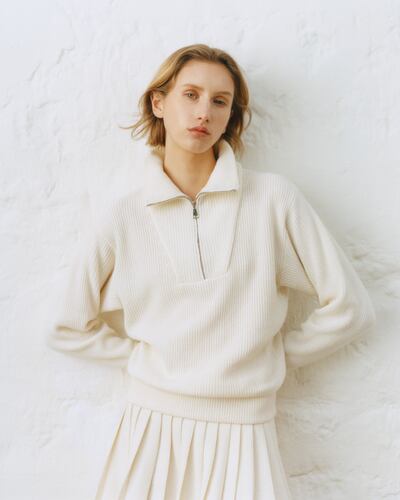
The Business of Fashion
Agenda-setting intelligence, analysis and advice for the global fashion community.

Agenda-setting intelligence, analysis and advice for the global fashion community.

Aimee Song has spent over 15 years building her personal brand online. With her next venture, however, she wants to take a more behind-the-scenes role.
This week, the influencer, who rose to prominence in the early 2010s as a fashion blogger and currently has over 7 million followers on Instagram, is launching Amiya, a luxury clothing label. The line, which has been in development for the past two years, will be focussed on knitwear. The initial drop of 10 items will include a $925 crewneck sweater, a $790 collared cardigan and a $1,450 half-zip sweater but also a cashmere miniskirt ($950) and two pairs of pants, one tailored ($875) and one relaxed ($1,075). All of Amiya’s products are made in Italy at factories scouted by Song and her husband and business partner, Jacopo Moschin. To start, Amiya will be sold exclusively on its own website, with hopes to expand into wholesale by early 2025. In the future, the brand plans to offer new categories, including homewares such as blankets and ceramics.
This isn’t Song’s first clothing line. In 2019, she released a 50-piece collection with Revolve under her Song of Style moniker, the retailer’s first product collaboration with an influencer. The label is still for sale on Revolve’s website today.
Song said working with Revolve was a “great experience” and taught her about the operational side of what goes into making a clothing brand. But now, she wants more control, including the ability to work on a slower production schedule, and to sell to a consumer that more closely align with her personal aesthetic.
ADVERTISEMENT
“It was catered towards the Revolve audience. At the end of the day, I just felt like it didn’t really represent who I was,” she said. “I didn’t want to come up with new designs every month and [at Revolve] it’s all about newness, because that’s their business model … I want to be much more intentional.”
With Amiya, Song wants to create clothing that would appeal to women like her: timeless staples that can stay in a closet year after year. Now in her 30s and a mother, she finds herself looking for “just want to wear pieces that are going to last forever.” While she’ll discuss the brand on her own Instagram, she won’t star in its campaigns.
Song’s own pivot speaks to a shift happening in the influencer space at large. In the late 2010s, retailers and investors tapped influencers for collaborations or to start new brands. It seemed that was the inevitable next step for the industry — if these internet celebrities could sell another company’s clothes, it should be easy for them to sell apparel under their own name.
But the reality proved different. While many influencer-led brands launched with big first-day sales and a lot of attention, momentum usually faded fast. Fashion blogger Julia Berolzheimer launched Gal Meets Glam — named for her blog — in 2018 with womenswear label Maggy London, only to shutter it in 2020, saying that the volume required had forced her to release product she wasn’t proud of. After a fast start in 2020, influencer Arielle Charnas’ Something Navy brand closed its stores and website last year. A deal to sell the brand for $1 fell through in January, according to The New York Post.
For influencers who can earn thousands of dollars on a single Instagram post, operating a fashion brand may simply not be worth the effort. Their experience with branding and marketing doesn’t always carry over into deft handling of the nuts and bolts of running a fashion business. There are difficult mechanics around fit, and necessary-but-expensive advertising, manufacturing and shipping costs. Business partners can handle the logistics, but often bring their own pressures around production and design.

“You get to express creativity in a new and different way by making products but, you also have to do … all that stuff that is really difficult and complex and just has nothing to do with being a content creator.” said James Nord, founder and CEO of the influencer marketing company Fohr.
However, a new sort of influencer brand has started taking shape, typically with little or no outside investment and less-grandiose goals. After closing Gal Meets Glam, in 2022, Berolzheimer launched Parterre, a brand that sells dresses, homewares and more, but with fewer individual products and a slower release schedule.
Amiya, which is self-funded, isn’t geared towards the growth game that tripped up so many influencer brands. The plan is to manufacture limited quantities of each item, which for the first year, will be released in themed drops. It’ll start with four drops per year, but may add two more for collaborations or special launches, and they won’t be tied to seasons. The goal is not to build a fast-growing fashion brand that gets acquired for hundreds of millions of dollars, but instead to create a business that can last, even if it never reaches those heights.
ADVERTISEMENT
“We do not want to grow fast, we want to take our time,” said Moschin. “We want our product to always be top notch and being small allows us to do that.”
Amiya also offers Song, who has been in the public eye for the better part of 15 years, to explore a venture that’s less reliant on her own image.
While Song believes her audience will be fans of the brand, not overusing her name and image increases the chance for it to reach a customer that doesn’t follow her on Instagram, and may never have heard of her at all.
It’s a move we’ll likely see more savvy influencers make as they look to build their businesses beyond the social media platforms that catapulted them to success. Influencers are increasingly experimenting with a variety of revenue streams, including subscriptions, to diversify their incomes.
“Even for someone with a million followers, most people walking down the street probably don’t know who she is, so there’s a fairly limited amount of brand value to those names,” Nord said. “And they’re wrapped up in personalities that some people really like, but some people really don’t. In letting a brand stand on its own, you get the benefits of your name and audience, but without any [potential] negative connotation.”
For Song, the hope is that Amiya will eventually be her “core” revenue stream, and will allow her complete flexibility on what brand deals she chooses to take on.
“I’ve said no to so many brand deals and partnerships, because anything I do, I just want to be so true to myself,” she said. “I wanted to do something that represents that.”
As social media users tune out ads, content creators are putting more of their content behind a paywall. The hope is they can build a deeper connection with their followers – and make more money, too.
Despite a series of public controversies in 2020, the social media star’s clothing brand, WeWoreWhat, is setting revenue records and breaking into new categories. BoF spoke to Bernstein about her experience with “cancel culture” and how the brand survived.
Recent controversies from Tarte, Shein and even Bud Light have demonstrated the risks that come with building marketing campaigns around social media stars — and provided learnings for how to operate in the sector today.

Diana Pearl is News and Features Editor at The Business of Fashion. She is based in New York and drives BoF’s marketing and media coverage.
When done effectively, a cultural partnership can rightfully earn its own place in the zeitgeist. But it’s not so easy as just hiring a celebrity to star in an ad campaign; brands must choose a partner that makes sense, find the format that fits best and amplify that message to consumers.
Calvin Klein’s chief marketing officer Jonathan Bottomley speaks to Imran Amed about the strategy behind the brand’s buzzy Jeremy Allen White-fronted campaign.
Often left out of the picture in a youth-obsessed industry, selling to Gen-X and Baby Boomer shoppers is more important than ever as their economic power grows.
This month, BoF Careers provides essential sector insights to help PR & communications professionals decode fashion’s creative landscape.